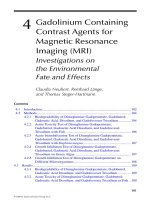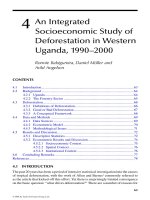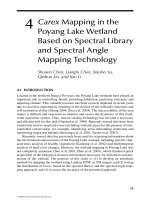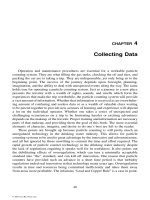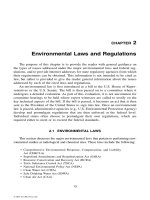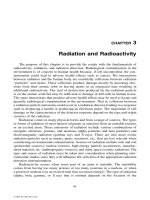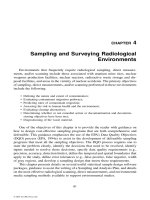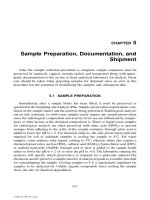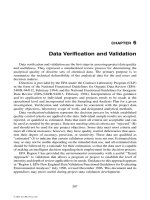SAMPLING AND SURVEYING RADIOLOGICAL ENVIRONMENTS - CHAPTER 4 pot
Bạn đang xem bản rút gọn của tài liệu. Xem và tải ngay bản đầy đủ của tài liệu tại đây (2.5 MB, 210 trang )
61
CHAPTER
4
Sampling and Surveying Radiological
Environments
Environments that frequently require radiological sampling, direct measure-
ments, and/or scanning include those associated with uranium mine sites, nuclear
weapons production facilities, nuclear reactors, radioactive waste storage and dis-
posal facilities, and areas in the vicinity of nuclear accidents. The primary objectives
of sampling, direct measurements, and/or scanning performed in these environments
include the following:
• Defining the nature and extent of contamination;
• Evaluating contaminant migration pathways;
• Predicting rates of contaminant migration;
• Assessing the risk to human health and the environment;
• Evaluating cleanup alternatives;
• Determining whether or not remedial action or decontamination and decommis-
sioning objectives have been met;
• Dispositioning of the waste material.
One of the objectives of this chapter is to provide the reader with guidance on
how to design cost-effective sampling programs that are both comprehensive and
defensible. This guidance emphasizes the use of the EPA’s Data Quality Objectives
(DQO) process (EPA, 1994a) to assist in the development of defensible sampling
programs that meet all the sampling objectives. The DQO process requires one to
state the problem clearly, identify the decisions that need to be resolved, identify
inputs needed to resolve those decisions, specify data quality requirements (e.g.,
precision, accuracy, detection limits), define the temporal and spatial boundaries that
apply to the study, define error tolerances (e.g., false positive, false negative, width
of gray region), and develop a sampling design that meets these requirements.
This chapter presents details on several useful statistical sample design software
packages, guidance to assist the writing of a Sampling and Analysis Plan, and details
on the most effective radiological scanning, direct measurements, and environmental
media sampling methods available to support environmental studies.
© 2001 by CRC Press LLC
62 SAMPLING AND SURVEYING RADIOLOGICAL ENVIRONMENTS
4.1 DESIGNING A DEFENSIBLE SAMPLING PROGRAM
Each year, the EPA and the regulated community spend approximately $5 billion
collecting environmental data for scientific research, regulatory decision making,
and regulatory compliance. To ensure that these data are of sufficient quality and
quantity to support defensible decisions, the process of collecting and analyzing data
itself must be scientifically defensible.
When designing a sampling program for an environmental study, the goal should
be to collect data of sufficient quality and quantity to resolve all of the decisions
that need to be made to complete the entire study. Since substantial cost is incurred
with the mobilization and demobilization of a field sampling team, every effort
should be made to perform all of the required sampling and analysis under one
mobilization.
Figure 4.1 identifies all of the key steps that are required to develop and imple-
ment a defensible sampling program that supports the environmental decision-
making process. This life-cycle process was modified after the process developed
and implemented by Bechtel Hanford, Inc., Department of Energy, and EPA (1997).
The following sections provide guidance on implementing each of the nine
components of the data life cycle. If any one of the nine components is overlooked,
the defensibility of the decision-making process will be severely impacted.
4.1.1 DQO Implementation Process
Prior to implementing the seven-step EPA DQO process, a number of preparatory
steps must first be implemented. These steps include holding a project planning
Figure 4.1 Data life cycle.
© 2001 by CRC Press LLC
SAMPLING AND SURVEYING RADIOLOGICAL ENVIRONMENTS 63
meeting, performing a thorough scoping effort, holding interviews with the regula-
tors who will be involved in the decision-making process, and holding a Global
Issues Meeting to resolve any disagreements with the requirements specified by the
regulators, or disagreements between two or more regulatory agencies. If these
preparatory steps are not implemented prior to beginning the seven-step process, the
seven-step process will drag on for weeks or months because all of the required
information needed to support the process will not be available.
4.1.1.1 Planning Meeting
The project manager should schedule and conduct a planning meeting with one
or more technical advisors who have experience performing projects with a similar
scope. The purpose of this meeting is to identify the project schedule, budget, staffing
needs (DQO team), regulators, and procurement requirements. The size of the DQO
team will vary between projects and is dependent upon the complexity of the
problem. Examples of technical backgrounds that may be needed on the DQO team
are provided in Section 4.1.5.1.3. The regulators are typically federal (e.g., EPA,
NRC, DOE), state, and/or local regulators. Once the objectives of the planning
meeting have been met, the project manager may begin the scoping process.
4.1.1.2 Scoping
An essential component to designing a defensible sampling program is scoping.
Scoping involves the review and evaluation of all applicable historical documents,
records, data sets, maps, diagrams, and photographs related to process operations,
spills and releases, waste handling and disposal practices, and previous environmen-
tal investigations. The results from the scoping process are used in Step 1 (Section
4.1.1.5.1) of the DQO process to:
• Identify the contaminants of concern (COCs);
• Support the development of a conceptual site model;
• Develop a clear statement of the problem.
Since the results from the scoping process are used as the foundation upon which
the sampling program will be designed, a project team should never attempt to rush
through the scoping process in efforts to save money. Doing so could lead to the
misidentification of the COCs, and the development of severely flawed conceptual
site model and problem statement.
The scoping checklist presented in Table 4.1 identifies the key elements that
should be researched during the scoping process. Table 4.1 is designed to assist the
project manager in assigning scoping items to individual team members and docu-
menting the results. A site visit should be scheduled following the completion of
the scoping effort to familiarize the project team with the current site conditions. In
addition, interviews should be scheduled and performed to verify that the information
© 2001 by CRC Press LLC
64 SAMPLING AND SURVEYING RADIOLOGICAL ENVIRONMENTS
gathered during the scoping process is accurate, and to assist in filling in any
informational data gaps. These interviews should include:
• Historical site workers/managers/owners;
• Federal, state, and/or local regulators;
• Potentially responsible parties (PRPs).
Interviews performed with federal, state, and/or local regulators should identify
specific regulatory requirements that must be taken into consideration, and general
concerns that they have related to the project. Examples of requirements and/or
concerns expressed by regulatory agencies include:
• Cleanup guidelines
• Enforceable deadlines
• Waste classification and disposal requirements
• Preferred alternative actions for cleaning up the site
• Favored sampling and/or survey methods
Table 4.1 Scoping Checklist
Project Title:
Process Knowledge and Historical Information
1. Evaluation and Summary of Process Knowledge: Review historical records to identify the
types of processes that were implemented at the site, the contaminants of concern, the
types and estimated quantities of chemicals and radionuclides used, and any spills that
may have occurred (note volume and type of chemical spilled).
Person Assigned Responsibility:
Summary:
2. Evaluation and Summary of Existing Information: Review all existing historical reports,
analytical data, maps, diagrams, photographs, waste inventories, geophysical logs,
drilling records, and other documents and/or records that could provide valuable
information about the site under investigation.
Person Assigned Responsibility:
Summary:
Regulatory Issues
1. Identify All Applicable Regulatory Guidelines: Review regulations and agreements for the
purpose of defining all applicable standards or risk-based guidelines for the various types
of environmental media (e.g., groundwater, surface water, soil, air) that may be impacted
at the site.
Person Assigned Responsibility:
Summary:
2. Identify all Agreements, or Regulatory/Statutory Obligations and Constraints: Identify all
previously agreed upon milestones with regulatory agencies, waste acceptance criteria,
and Applicable or Relevant and Appropriate Requirements (ARARs). Identify what
regulatory pathway should be followed (e.g., RCRA, CERCLA, NEPA).
Person Assigned Responsibility:
Summary:
3. Identify All Regulatory Issues Pertaining to Waste Management: Identify Land Disposal
Restrictions (LDR) that apply to waste material derived from the site. Identify waste
acceptance criteria for potential waste disposal facilities.
Person Assigned Responsibility:
Summary:
© 2001 by CRC Press LLC
SAMPLING AND SURVEYING RADIOLOGICAL ENVIRONMENTS 65
4.1.1.3 Regulator Interviews
The regulators for a project may include federal (e.g., EPA, NRC, DOE), state,
and/or local representatives who are responsible for making decisions on issues such
as cleanup guidelines, deliverable milestone dates, waste classification and disposal
requirements, preferred remedial alternatives, and/or favored sampling methods.
Prior to the commencement of the DQO process, the project manager should
contact federal, state, and local regulatory agencies to identify the names of the
Cultural Issues
1. Identify All Cultural Issues That Must Be Taken into Consideration: Identify any Native
American populations that may be impacted (e.g., burial grounds), or other cultural
related issues that should be taken into consideration.
Person Assigned Responsibility:
Summary:
Ecological Risk Assessment Issues
1. Identify All Ecological Issues That Must Be Taken into Consideration: Identify any
threatened or endangered species of plants or animals that may be present in the vicinity
of the site. Identify the potential contaminant sources, pathways, and receptors.
Person Assigned Responsibility:
Summary:
Human Health Risk Assessment Issues
1. Identify All Human Health Concerns Associated with the Site: Use the identified existing
information to perform a preliminary assessment of all potential chemical, radiological,
and physical health hazards that may be encountered at the site. Identify the potential
contaminant sources, pathways, and receptors.
Person Assigned Responsibility:
Summary:
Other Issues
1. Identify Potential Data Uses: Identify all of the potential uses for existing or new analytical
data. These uses may include defining the nature and extent of contamination, risk
assessment, feasibility studies, treatability studies, remedial design, postremediation
confirmation sampling, etc.
Person Assigned Responsibility:
Summary:
2. Identify Sampling, Surveying, and/or Analytical Methods That Should Be Considered:
Identify sample collection methods, field surveying methods, on-site laboratory methods,
and laboratory methods that should be taken into consideration. Provide advantages
and disadvantages to using each method, and general performance capabilities (e.g.,
detection limits, precision, accuracy).
Person Assigned Responsibility:
Summary:
3. Identify Potential Risk Assessment Models That Should Be Considered: Provide the name
of each model (e.g., RESRAD), the input requirements (e.g., Ra-226 activity levels in
surface soil), and advantages and disadvantages of each.
Person Assigned Responsibility:
Summary:
Table 4.1 (continued) Scoping Checklist
© 2001 by CRC Press LLC
66 SAMPLING AND SURVEYING RADIOLOGICAL ENVIRONMENTS
representatives who will be involved with the project. Once the regulators have been
identified, a 1- to 2-h interview should be scheduled with each of them individually.
The purpose of the interview is to identify all of the key issues of concern that will
need to be addressed by the DQO process. The project manager should consider
bringing a few key technical experts to the regulator interviews to answer any
technical questions that may arise.
4.1.1.4 Global Issues Meeting
A Global Issues Meeting is held whenever there are disagreements with any of
the requirements specified by the regulators, or when the requirements from one
regulator contradict the requirements of one of the other regulators. For example,
the federal regulator may require the site under investigation to be remediated in
accordance with the CERCLA process, while the state regulator may require the site
to be remediated in accordance with the RCRA process. This meeting should be
attended by the project manager, key technical project staff, and all of the regulators.
All agreements made at the conclusion of the Global Issues Meeting should be
carefully documented in a memorandum that is then entered into the document record.
4.1.1.5 Seven-Step DQO Process
The seven-step DQO process is a strategic planning approach developed by the
EPA (EPA, 1994a) to prepare for data collection activities. This process provides a
systematic procedure for defining the criteria that a data collection design should
satisfy, including when/where/how to collect samples/measurements, tolerable limits
on decision errors, and how many samples/measurements to collect. One of the
advantages of the DQO process is that it enables data users and relevant technical
experts to participate in the data collection planning process, where they can specify
their specific data needs prior to data collection.
The DQO process should be implemented during the planning stage of an inves-
tigation prior to data collection. Using this process will ensure that the type, quantity,
and quality of the environmental data used in the decision-making process will be
appropriate for the intended application. The DQO process is intended to minimize
expenditures related to data collection by eliminating unnecessary, duplicative, or
overly precise data. In addition, the DQO process ensures that resources will not be
committed to data collection efforts that do not support a defensible decision.
The DQO process consists of the seven steps identified in Figure 4.2. The output
from each step influences the choices that will be made later in the process. Even
though the DQO process is depicted as a linear sequence of steps, in practice, the
process is iterative. In other words, the outputs from one step may lead to reconsid-
eration of prior steps. This iterative approach should be encouraged because it will
ultimately lead to a more efficient data collection design. During the first six steps
of the process, the DQO team will develop the decision performance criteria,
otherwise referred to as DQOs. The final step of the process involves developing
the data collection design based on the DQOs.
© 2001 by CRC Press LLC
SAMPLING AND SURVEYING RADIOLOGICAL ENVIRONMENTS 67
The first six steps must be completed prior to developing the data collection
design. In Figure 4.2, the iterative link between DQO Steps 1 through 6 and DQO
Step 7 “Optimize the Design” is illustrated by double arrows, which signify that it
may be necessary to revisit any one or more of the first six steps to develop a feasible
and appropriate data collection design. The DQO workbook template found in
Appendix A and the accompanying CD-ROM should be used to help the user
implement the DQO process. This workbook was developed as a joint effort between
the author and Bechtel Hanford, Inc., technical staff. The results from the DQO
process should then be used to support the preparation of a Sampling and Analysis
Plan (see Section 4.1.1.7).
The key activities that are performed for each of the seven steps are summarized
in Table 4.2. A more-detailed discussion of each of these steps is presented in the
following sections.
4.1.1.5.1 Step 1: State the Problem
Objective: To define the problem clearly so that the focus of the project will be
unambiguous.
Activities:
• Identify task objectives and assumptions.
• Identify members of the DQO team.
• Identify the regulators.
• Specify budget requirements and relevant deadlines.
• Identify the contaminants of concern.
• Develop conceptual site model.
• Develop a concise statement of the problem.
Figure 4.2 Seven steps that comprise the DQO process.
© 2001 by CRC Press LLC
68 SAMPLING AND SURVEYING RADIOLOGICAL ENVIRONMENTS
Table 4.2 DQO Seven-Step Process
DQO Step No. Activities
Step 1: State the Problem • Identify the contaminants of concern
• Develop a conceptual site model
• Formulate a concise problem statement
Step 2: Identify the Decisions • Identify the principal study questions (PSQs) that the study
will attempt to resolve
• Identify the alternative actions that may result once each of
the PSQs has been resolved
• Join the PSQs and alternative actions to form decision
statements
Step 3: Identify Inputs to the
Decisions
• Identify the information needed to resolve each decision
statement
• Determine the source and level of quality for the information
needed
• Determine whether or not data of adequate quality already
exist
Step 4: Define the Study Area
Boundaries
• Define the population of interest and the geographic
area/volume to which each decision statement applies
• Divide the population into strata (statistical) that have
relatively homogeneous characteristics
• Define the temporal boundaries of the problem
— Time frame to which each decision applies
— When to collect the data
• Define the scale of decision making
Step 5: Develop Decision
Rules
• Define the statistical parameter of interest (e.g., mean)
• Define the final action level
• Develop decision rules which are “if … then … ” statements
that incorporate the parameter of interest, scale of decision
making, action level, and alternative actions that would result
from the resolution of the decision
Step 6: Specify Limits on • Select between a statistical and nonstatistical sample design:
Decision Errors — Define the expected concentration range for the
parameter of interest
— Identify the two types of decision error
— Define the null hypothesis
1. Define boundaries of the gray region
2. Define tolerable limits for decision error
Step 7: Optimize the Sampling Nonstatistical Design:
Design • Provide summary of applicable surveying method
alternatives
• Provide summary of applicable sampling method alternatives
• Develop an integrated sampling design
Statistical Design:
• Identify statistical sampling design alternatives (e.g., simple
random, stratified random) and select the preferred
alternative
• Select the statistical hypothesis test for testing the null
hypothesis
• Evaluate multiple design options by varying the decision error
criteria and width of the gray region
• Select the preferred sampling design
© 2001 by CRC Press LLC
SAMPLING AND SURVEYING RADIOLOGICAL ENVIRONMENTS 69
Outputs:
• Administrative and logistical elements
• Concise statement of the problem
4.1.1.5.1.1 Background — In the process of defining the problem to be resolved,
a combination of administrative and technical activities needs to be performed. The
administrative activities include identifying the project objectives and assumptions,
identifying the members of the DQO team and the regulators, and specifying budget
requirements and relevant deadlines. The technical activities include identifying the
contaminants of concern, developing a conceptual site model, and developing a
concise statement of the problem.
4.1.1.5.1.2 Identify Task Objectives and Assumptions — This activity involves
the development of a clear statement of the task objectives as they pertain to remedial
activities. Initially identify the objectives on a large scale; then focus on the task-
specific objectives. Identify all of the task-specific assumptions that have been made
based on DQO team discussions and interviews with the regulators.
4.1.1.5.1.3 Identify Members of the DQO Team — The project manager iden-
tifies the members of the DQO team in the planning meeting (Section 4.1.1.1). The
DQO team should be composed of technical staff members with a broad range of
technical backgrounds. The number of members on the team should be directly
related to the size and complexity of the problem. Complex tasks may require a
team of ten or more members, while simpler tasks only require a few members. The
required technical backgrounds for the DQO team members will vary depending on
the scope of the project, but often include:
• Radiochemistry
• Hydrogeology
• Environmental engineering
• Radiation safety
• Statistics
• Groundwater/surface water/air modeling
• Quality assurance
• Waste management
• Risk assessment
• Remedial design
4.1.1.5.1.4 Identify the Regulators — The project manager identifies the regula-
tors in the planning meeting (Section 4.1.1.1). Regulators are those who have
authority over the study, and are responsible for making final decisions based on
the recommendations of the DQO team. The regulators are often representatives of:
• Department of Energy
• Department of Defense
• Nuclear Regulatory Commission
© 2001 by CRC Press LLC
70 SAMPLING AND SURVEYING RADIOLOGICAL ENVIRONMENTS
• Environmental Protection Agency
• State regulatory agencies
• Local regulatory agencies
The project manager should encourage early regulator involvement since this
will help ensure that the task stays on track.
4.1.1.5.1.5 Specify Budget Requirements and Relevant Deadlines — The
project manager identifies the budget requirements and relevant deadlines in the
planning meeting (Section 4.1.1.1). The specified budget requirement should include
the cost for:
• Implementing the DQO process
• Preparing a DQO Summary Report
• Preparing a Sampling and Analysis Plan
• Implementing sampling activities
• Performing laboratory analyses
• Performing data verification/validation
• Performing data quality assessment
• Evaluating the resulting data
Identify all deadlines for completion of the study and any intermediate deadlines
that may need to be met.
4.1.1.5.1.6 Develop a Conceptual Site Model — A conceptual site model is
either a tabular or graphical depiction of the best understanding of the site conditions.
The process of developing a conceptual site model helps one to identify any data
gaps that may exist. The conceptual site model should identify:
• Primary and secondary sources of contamination
• Release mechanisms
• Pathways for contaminant migration
• Routes for exposure
• Receptors
In the example provided in Table 4.3 and Figure 4.3 the primary and secondary
sources of contamination are the piles of chipped radiologically contaminated metal
and the contaminated soils/sediment/water (surface water/groundwater) in the vicin-
ity of the chipped metal piles, respectively. The contaminated metal chips were
brought on site by railcar from another contaminated location. The contamination
from the metal chips migrated into the surrounding soil, and was carried by surface
water to a small nearby pond. Contamination was also transported by groundwater
to a nearby drinking water well. The release mechanisms include wind, rain, pumping
groundwater from the drinking water well, and/or human receptors walking through
the contaminated area. The pathways for contaminant migration include air, surface
© 2001 by CRC Press LLC
SAMPLING AND SURVEYING RADIOLOGICAL ENVIRONMENTS 71
water, and groundwater. The routes of exposure include the receptors breathing air
containing radiologically contaminated dust particles, dermal contact with contam-
inated chipped metal and soil, and ingestion of contaminated soil, sediment, surface
water, and/or groundwater. The receptors are humans living on the property, humans
eating livestock/agricultural products from the property, and the surrounding eco-
logical population.
The conceptual site model should be continuously refined throughout the imple-
mentation of the DQO process and sampling program.
4.1.1.5.1.7 Develop a Concise Statement of the Problem — Develop a con-
cise problem statement that describes the problem as it is currently understood. The
statement should be based on the conceptual site model described above.
4.1.1.5.2 Step 2: Identify the Decisions
Objective: Develop decision statements that address the concerns highlighted in
the problem statement.
Activities:
• Identify the principal study questions (PSQs).
• Define the alternative actions.
• Join the PSQs and alternative actions into decision statements.
Outputs: Decision statements
4.1.1.5.2.1 Identify Principal Study Questions — The first activity to be per-
formed under DQO Step 2 is identifying all of the PSQs. The PSQs are used to
narrow the search for information needed to address the problem identified in DQO
Step 1. The PSQs identify key unknown conditions or unresolved issues that reveal
the solution to the problem. Note that only questions that require environmental data
should be included as PSQs. For example, questions such as “Should a split-spoon
or solid-tube sampler be used to collect the soil samples?” should not be included
in the DQO process since this decision should be made based on experience and
requires no analytical data to answer. The answers to the PSQs will provide the basis
for determining what course of action should be taken to solve the problem.
4.1.1.5.2.2 Define Alternative Actions — Identify possible alternative actions
that may be taken to solve the problem (including the alternative that requires no
action). Alternative actions are taken only after the PSQ is resolved. Alternative
actions are not taken to resolve the PSQ. Once the alternative actions have been
identified, perform a qualitative assessment of the consequences of taking each
alternative action if it is the wrong action. In other words, if one implements the
no-action alternative when one should have implemented a soil removal action at a
future day-care center, what are the potential consequences of this mistake?
© 2001 by CRC Press LLC
72 SAMPLING AND SURVEYING RADIOLOGICAL ENVIRONMENTS
Table 4.3 Example of a Tabular Conceptual Site Model
Primary Source of
Contamination
Secondary Source of
Contamination Release Mechanisms Migration Pathways Exposure Routes Receptors
Chips of radiologically
contaminated metal
brought onto the site
by railcar
Contaminated soil
immediately
surrounding the
chipped metal piles
Wind, rain, human
receptors walking
over soil
Air, surface water,
groundwater
Inhalation, dermal
contact, ingestion
Humans living on
property, humans eating
livestock/agricultural
products, terrestrial
ecological population,
and birds of prey
Contaminated
sediment within
drainage channels
leading to a nearby
pond
Wind, rain Air, surface water,
groundwater
Inhalation, dermal
contact, ingestion
Humans living on
property, humans eating
livestock/agricultural
products, terrestrial
ecological population,
and birds of prey
Contaminated
sediment at the base
of a nearby pond
Percolation of pond
water to underlying
groundwater
Air, surface water,
groundwater
Inhalation, dermal
contact, ingestion
Humans living on
property, humans eating
livestock/agricultural
products, and aquatic
ecological population
© 2001 by CRC Press LLC
SAMPLING AND SURVEYING RADIOLOGICAL ENVIRONMENTS 73
Express the consequences using the following terms:
•Low
• Moderate
• Severe
When assessing consequences, take the following aspects into consideration:
• Human health
• Environment (flora/fauna)
• Political
• Economic
•Legal
The results from this assessment will be used later in DQO Step 6 to assist in the
selection between a statistical or nonstatistical sampling design.
4.1.1.5.2.3 Formulate Decision Statements — Decision statements are devel-
oped by linking PSQs with their corresponding alternative actions. The following
format should be used when formulating the decision statements:
Determine whether or not [unknown environmental condition/issue/criterion from the
problem statement] requires [taking alternative actions].
The following is an example of a correctly formatted decision statement:
Determine whether or not the sediment in the study area pond exceeds one or more
cleanup guidelines and requires removal and disposal in a radiological landfill, or if
no action is required.
Figure 4.3 Graphical depiction of a conceptual site model
© 2001 by CRC Press LLC
74 SAMPLING AND SURVEYING RADIOLOGICAL ENVIRONMENTS
4.1.1.5.3 Step 3: Identify Inputs to the Decisions
Objective: To identify the informational inputs that will be required to resolve
the decision statements identified in DQO Step 2, and to determine
which inputs require environmental measurements.
Activities:
• Identify information required to resolve each decision statement.
• Determine the source(s) for each item of information identified.
• Determine the level of quality required for the data.
• Evaluate the appropriateness of existing data.
• Identify the information needed to establish the action level.
• Confirm that appropriate analytical methods exist to provide the necessary data.
Outputs: Information needed to resolve decision statements
4.1.1.5.3.1 Identify Information Required to Resolve Each Decision
Statement — Generally, all of the decisions identified in DQO Step 2 will be
resolved by data (existing or new) from either environmental measurements or from
scientific literature. Modeling may be used to resolve some decisions. However, all
models require some input data (existing or new) to run the model.
For each decision statement, create a list of environmental variables of interest
for which environmental measurements may be required. Examples of these vari-
ables include:
• U-238, Ra-226, Th-230, and Th-232 activity levels in shallow and deep soil;
• Metals concentrations in shallow and deep soil;
• U-238, Ra-226, Th-230, and Th-232 activity levels in surface water;
• Metals concentrations in surface water;
• U-238, Ra-226, Th-230, and Th-232 activity levels in groundwater;
• Metals concentrations in groundwater;
• Fixed and removable gross alpha and gross beta/gamma activity on building floor
surfaces.
4.1.1.5.3.2 Determine the Source(s) for Each Item of Information
Identified — Identify and list all of the potential sources of information that may
be able to address each of the environmental variables identified in Section
4.1.1.5.3.1. Examples of potential data sources include:
• New data collection activities
• Previous data collection activities
• Historical records
• Scientific literature
• Regulatory guidance
• Professional judgment
• Modeling
© 2001 by CRC Press LLC
SAMPLING AND SURVEYING RADIOLOGICAL ENVIRONMENTS 75
4.1.1.5.3.3 Determine the Level of Quality Required for the Data — When
determining the level of data quality required to resolve each decision, one should
take into consideration human health, ecological, political, cost, and legal conse-
quences of taking each of the alternative actions.
The four general levels of data quality presented from the lowest cost (highest
detection limits) to highest cost (lowest detection limits) include:
• Field screening measurements
• On-site laboratory analyses
• Standard laboratory analyses
• CLP laboratory analyses
To minimize cost, one should consider collecting a larger number of low-cost
field screening measurements and/or on-site laboratory analyses with 5 to 10% of
the samples being sent to a fixed laboratory for confirmation analysis (standard or
CLP analysis). This assumes that detection limit requirements can be met by the
field screening or on-site laboratory analyses.
4.1.1.5.3.4 Evaluate the Appropriateness of Existing Data: Usability
Assessment — To determine whether an existing data set is of adequate quality
to resolve one or more decision statements, one must evaluate the results from the
accompanying quality control data. Quality control data should include the results
from the analysis of:
• Spike samples
• Duplicate samples
• Blank samples
The results from spike and duplicate samples are used to estimate the accuracy
and precision of the analytical methods, respectively. Blank samples are analyzed
to show the instrument was not contaminated from the analysis of previous
samples.
When evaluating the appropriateness of existing data, one should also take into
consideration:
• Instrument detection limits;
• Types of samples collected (e.g., grab, composite, integrated);
• Sample collection design (e.g., random, systematic, judgmental).
Remove data that are of poor quality, do not have low enough detection limits, or
that are not representative of the population.
4.1.1.5.3.5 Identify the Information Needed to Establish the Action
Level — The action level is the threshold value that provides the criterion for
choosing between alternative actions. The action level may be based on:
© 2001 by CRC Press LLC
76 SAMPLING AND SURVEYING RADIOLOGICAL ENVIRONMENTS
• Regulatory thresholds or standards, e.g., maximum contaminant levels (MCLs),
land disposal restrictions (LDRs);
• Problem-specific risk analysis, e.g., preliminary remediation goals (PRG).
Simply determine the criteria that will be used to set the numerical value for the action
level. The actual numerical action level is set in DQO Step 5 (Section 4.1.1.5.5).
4.1.1.5.3.6 Confirm That Appropriate Analytical Methods Exist — For any
new environmental measurements to be made, develop a comprehensive list of
potentially appropriate measurement methods. Use the list of environmental vari-
ables of interest identified earlier in this step (Section 4.1.1.5.3.1).
4.1.1.5.4 Step 4: Define the Study Area Boundaries
Objective: To define the spatial and temporal boundaries that are covered by each
decision statement.
Activities:
• Define the population of interest.
• Define the spatial boundaries of each decision statement.
• Define the temporal boundary of each decision statement.
• Define the scale of decision making.
• Identify any practical constraints on data collection.
Outputs: Definition of scale of decision making
4.1.1.5.4.1 Define the Population of Interest — It is difficult to make a decision
with data that has not been drawn from a well-defined population. The term popu-
lation refers to the total universe of objects to be studied, from which an estimate
will be made. For example, if one is collecting surface soil samples from a football
field to determine the U-238 concentration in the soil, the population is the total
number of potential 1-kg soil samples that could be collected to a depth of 6 in.
within the perimeter of the field.
Since it would be cost-prohibitive to sample and analyze every member of the
population for U-238 concentrations, a statistical “sample” of the population is
collected to provide an estimate of the U-238 concentrations in the population. Keep
in mind this estimate will have error associated with it.
Other examples of the population of interest include:
• All subsurface soil samples (1 kg) within the area of interest to a depth of 15 ft;
• All surface water samples (1 L) within perimeter boundaries of the pond;
• All sediment samples (1 kg) from the top 0.5 ft of the lake bottom;
• All direct surface activity measurement areas (100 cm
2
) on the building floor and
wall surfaces.
© 2001 by CRC Press LLC
SAMPLING AND SURVEYING RADIOLOGICAL ENVIRONMENTS 77
4.1.1.5.4.2 Define the Spatial Boundaries of Each Decision
Statement — Define the geographic area to which each decision statement
applies. The geographic area is a region distinctively marked by some physical
feature, such as:
• Area (e.g., surface soil within the backyard of the Smith property);
• Volume (e.g., soil to a depth of 20 feet within the perimeter of the waste pit);
• Length (e.g., length of a pipeline);
• Some identifiable boundary (the natural habitat range of a particular animal/plant
species).
It is often necessary to divide the population into strata (statistical) that have
relatively homogeneous characteristics. Dividing the population into strata is desir-
able for the purpose of:
• Addressing subpopulations;
• Reducing variability;
• Reducing the complexity of the problem (breaking it into more manageable pieces).
Figures 4.4 and 4.5 provide examples of how two different sites may be stratified.
The stratification approach presented in Figure 4.4 is based on current and past land
use, while the stratification approach presented in Figure 4.5 is based on a site
inspection or preliminary data results.
4.1.1.5.4.3 Define the Temporal Boundary of Each Decision
Statement — Defining the temporal boundaries of a decision initially involves
determining when to collect the data. In other words, one must determine when
conditions will be most favorable for collecting data.
For example, a study to measure ambient airborne particulate matter may give
misleading information if the sampling is conducted in the wetter winter months
rather than the drier summer months. Several factors that should be considered when
determining when to collect data include:
• Temperature
• Humidity
• Wind direction
• Rainfall
• Amount of sunlight
• Presence of receptors (e.g., site workers only present during work hours)
When defining the temporal boundaries, one should also take into consideration
the time frame to which the decision applies. For example, if a residential property
is determined to have radiologically contaminated soil in the backyard, the time frame
to which a decision related to the risk condition of an average resident may be set
at 8 years if that were the average length of residence for one family in the home.
© 2001 by CRC Press LLC
78 SAMPLING AND SURVEYING RADIOLOGICAL ENVIRONMENTS
4.1.1.5.4.4 Define the Scale of Decision Making — The scale of decision
making merges the spatial and temporal boundaries described above. Two examples
of scales of decision making are presented below:
1. Surface soil (top 0.5 ft) within the backyard of the Smith property over the next
8 years (sampling to be performed under clear weather conditions, preferably
during summer months);
2. Soil to a depth of 20 ft within the perimeter of the waste pit over the next 6 months
(sampling to be performed under clear weather conditions with minimal wind).
Figure 4.6 presents a graphical illustration of how the scale of decision making
is defined.
Figure 4.4 Example 1 of site stratification based on current/past land use.
Figure 4.5 Example 2 of site stratification based on current/past land use.
© 2001 by CRC Press LLC
SAMPLING AND SURVEYING RADIOLOGICAL ENVIRONMENTS 79
4.1.1.5.4.5 Identify Any Practical Constraints on Data Collection — Identify
any constraints or obstacles that could potentially interfere with the full implemen-
tation of the data collection design. These should be taken into consideration in the
sampling design and when developing implementation schedules. Examples of these
constraints or obstacles include:
• Seasonal or meteorological conditions when sampling is not possible;
• Inability to gain site access or informed consent;
• Unavailability of personnel, time, or equipment;
• Presence of building or other structure that could prevent access to sampling
locations;
• Security clearance requirements to access site.
4.1.1.5.5 Step 5: Develop Decision Rules
Objective: Combine the parameter of interest, scale of decision making, action
level, and alternative actions to produce decision rules that provide a
logical basis for choosing between alternative actions.
Activities:
• Specify the statistical parameter to characterize the population.
• Specify the action level.
• Develop a decision rule.
Outputs: If/then decision rule statements
Figure 4.6 Defining the scale of decision making.
1. Define Geographic
Area of the
Investigation
4. Define Scale of Decision
Making for Surface or
Subsurface Soils
3. Stratify the Site
2. Define Population
of Interest
Study Boundaries
Surface Soil
(Top 0.5 Feet)
Subsurface Soil
Area of Known
Contamination
(Possible Source)
Area of Suspected
Contamination
Area Unlikely to be
Contaminated
0.5 Acre Exposure
Areas
Surface Soils
Subsurface Soils
Contaminated
Source
Water Table
(Saturated Zone)
© 2001 by CRC Press LLC
80 SAMPLING AND SURVEYING RADIOLOGICAL ENVIRONMENTS
4.1.1.5.5.1 Specify the Statistical Parameter to Characterize the
Population — The statistical parameter of interest is a descriptive measure (e.g.,
mean, median) that specifies the characteristic or attribute that the regulators would
like to know about the population. The statistical parameter of interest is used for
comparison against the action level to determine whether or not the remedial action
objectives have been met. Agreements made with regulatory agencies should specify
which statistical parameter of interest should be used.
4.1.1.5.5.2 Specify the Action Level — Specify the numerical action levels for
each of the contaminants of concern (COCs) for the purpose of allowing one to
choose between alternative actions. The action levels may either be regulatory
thresholds or standards (e.g., MCLs, LDRs), or they may be calculated based on a
problem-specific risk analysis (e.g., PRG). The specified action levels will require
regulator approval.
4.1.1.5.5.3 Develop a Decision Rule — For each of the decision statements
identified in DQO Step 2, develop a decision rule as an “if … then …” statement
that incorporates the parameter of interest, the scale of decision making, the action
level, and the action(s) that would result from resolution of the decision.
The recommended decision rule format is as follows:
If the [parameter of interest] within the [scale of decision] is greater than the [action
level], then take [alternative action A]; otherwise take [alternative action B].
Example 1
If the [mean activity of U-238 in the surface soil over the next 8 years] within [the
perimeter of the backyard of the Smith property] is greater than [7 pCi/g], then
[dispose of soil in a radiological landfill]; otherwise [leave the soil in place].
Example 2
If the mean concentration of cadmium in fly ash leachate over the next 6 months
within [a container truck] is greater than [1 mg/kg], then [the ash waste will be
considered hazardous and will be disposed of in an RCRA permitted landfill]; oth-
erwise [the waste fly ash will be disposed of in a municipal landfill].
4.1.1.5.6 Step 6: Specify Limits on Decision Errors
Objective: Since analytical data can only provide an estimate of the true con-
dition of a site, decisions that are based on such data could potentially
be in error. The purpose of this step is to define tolerable limits on
decision errors.
© 2001 by CRC Press LLC
SAMPLING AND SURVEYING RADIOLOGICAL ENVIRONMENTS 81
Activities:
• Select between a statistical and nonstatistical sample design.
• Determine the possible range of the parameter of interest.
• Identify the decision errors.
• Choose the null hypothesis.
• Specify the boundaries of the gray region.
• Assign tolerable limits on decision error.
Outputs:
• Boundaries of the gray region
• Decision error tolerances
4.1.1.5.6.1 Select between a Statistical and Nonstatistical Sample
Design — Since analytical data can only estimate the true condition of a site or
facility under investigation, decisions that are made based on measurement data
could potentially be in error (i.e., decision error). For this reason, the primary
objective of DQO Step 6 is to determine which decision statements require a statis-
tical vs. a nonstatistical sample design. For those decision statements requiring a
statistical design, DQO Step 6 defines tolerable limits on the probability of making
a decision error. For those decision statements requiring a nonstatistical design,
proceed to DQO Step 7 (Section 4.1.1.5.7).
The primary factors that should be taken into consideration in selecting a statis-
tical vs. a nonstatistical design include:
• The qualitative consequences (low/moderate/severe) of decision error;
• The accessibility of the site or facility if resampling is required;
• The time frame over which each of the decision statements applies.
A statistically based sample design should be used whenever the consequences
of decision error are moderate or severe. For example, if a child day-care center is
proposed to be built on top of a site that has been remediated, the consequences of
decision error (e.g., concluding the site is clean when it is contaminated) are severe
since children would be exposed to contamination, and therefore a statistical sam-
pling design is warranted.
The accessibility of the site if resampling is required will also impact the severity
of the decision error. For example, if a remediated site is to be covered with 15-ft
of backfill material after the site is pronounced clean followed by the construction
of a building, the consequences of decision error are severe because the backfill
material and potentially the building would need to be removed if it was later
determined that the site was still contaminated and additional remediation was
required. A statistical sample design is warranted for this situation.
The time frame for which a decision applies should be taken into consideration
when defining the severity of decision error. For example, decisions that apply for
© 2001 by CRC Press LLC
82 SAMPLING AND SURVEYING RADIOLOGICAL ENVIRONMENTS
only a few years have a less severe consequence than decisions that apply for 1000
years. For example, some decisions (e.g., those associated with defining the extent
of contamination) apply only until the site is remediated (a few years). On the other
hand, the decision that a remediated site is now clean may apply for thousands of
years depending upon the half-life of the radionuclides involved.
A nonstatistical sampling design may be used whenever the consequences of
decision error are relatively low. For example, if samples are being collected from
a waste material simply to determine the most appropriate storage area for the waste
while awaiting final characterization and disposition, a nonstatistical sampling design
is adequate. The consequence of decision error in this case is just the inconvenience
of moving the misidentified waste material after final characterization to the proper
area to await disposal.
4.1.1.5.6.2 Nonstatistical Sample Designs — For those decision statements
requiring a nonstatistical design, there is no need to define the range for the parameter
of interest, types of decision errors, null hypothesis, boundaries of the gray region,
or tolerable limits on decision error. These only apply to statistical sample designs.
Proceed to DQO Step 7 (Section 4.1.1.5.7).
4.1.1.5.6.3 Statistical Sample Designs — The purpose in using a statistical
sample design is to reduce the chances of making a decision error to a tolerable
level. DQO Step 6 provides a mechanism for the regulator to define tolerable limits
on the probability of making a decision error.
The two types of decision error that can occur include:
1. Walking away from a dirty site.
2. Cleaning up a clean site.
The decision error that causes one to walk away from a dirty site is the more serious
of the two consequences since it could negatively impact human health and the
environment. The decision error that causes one to clean up a clean site results in
higher remediation costs.
Figure 4.7 illustrates the decision error of walking away from a dirty site. In this
example, the true mean concentration (which only God knows) of an undefined
isotope is above the action level of 100 pCi/g, while the sample mean (calculated
based on a sample of the population) is below the action level. Since decisions are
made based on the sample mean, the site is incorrectly determined to be clean. The
action is to walk away from a dirty site. When the null hypothesis (Section
4.1.1.5.6.3.3) assumes the site to be contaminated until shown to be clean, the above
error is referred to as an “α error” or a “false positive.”
Figure 4.8 illustrates the decision error of cleaning up a clean site. In this
example, the true mean concentration (which only God knows) of an undefined
isotope is below the action level of 100 pCi/g, while the sample mean (calculated
based on a sample of the population) is above the action level. Since decisions are
made based on the sample mean, the site is incorrectly determined to be contami-
nated. The action is to clean up a clean site. When the null hypothesis assumes the
© 2001 by CRC Press LLC
SAMPLING AND SURVEYING RADIOLOGICAL ENVIRONMENTS 83
site to be contaminated until shown to be clean, the above error is referred to as a
“β error” or a “false negative.”
To control the amount of decision error for a sample design it is necessary to
define the range for the parameter of interest (e.g., mean, median), types of decision
errors, null hypothesis, boundaries of the gray region, and tolerable limits on decision
Figure 4.7 Decision error causing one to walk away from a dirty site.
Figure 4.8 Decision error causing one to clean up a clean site.
© 2001 by CRC Press LLC
84 SAMPLING AND SURVEYING RADIOLOGICAL ENVIRONMENTS
error. These criteria are needed to support statistical calculations performed in DQO
Step 7 when determining the required number of samples/measurements to collect.
4.1.1.5.6.3.1 Determine the possible range of the parameter of interest — An
initial step in the process of establishing a statistically based sample design is to
define the expected range of the statistical parameter of interest (e.g., mean, median)
for each COC. This should be defined using the results from historical analytical
data. If no historical data are available, process knowledge should be used to estimate
the expected range.
4.1.1.5.6.3.2 Identify the decision errors — The two types of decision error that
can occur are walking away from a dirty site and cleaning up a clean site. For a site
that is assumed to be contaminated until it is shown to be clean, the former is referred
to as a “false positive” or “α error” (see Figure 4.7). The latter is referred to as a
“false negative” or “β error” (see Figure 4.8). The α error has the more serious
consequence since it results in contamination being left behind where human and
ecological receptors could be impacted. The β error results in higher remediation
costs because one is unnecessarily cleaning up soil that is below the action level.
4.1.1.5.6.3.3 Choose the null hypothesis — In the process of establishing a sta-
tistically based sample design, it is necessary to define the null hypothesis or baseline
condition of the site. The two possible null hypotheses for environmental sites are
• The site is assumed to be contaminated until shown to be clean.
• The site is assumed to be clean until shown to be contaminated.
When selecting the null hypothesis, keep in mind that the null hypothesis should
state the “opposite” of what the project eventually hopes to demonstrate. Since for
an environmental site, the objective is almost always to show that a site is clean
after remediation is complete, the null hypothesis should assume the site is contam-
inated until shown to be clean.
4.1.1.5.6.3.4 Specify the boundaries of the gray region — The gray region is
a range of possible parameter values where the consequences of a decision error are
relatively minor. It is bounded on one side by the action level, and on the other side
by the parameter value where the consequences of decision error begin to be sig-
nificant (Figure 4.9). It is necessary to specify the gray region because variability
in the population and unavoidable imprecision in the measurement system combine
to produce variability in the data such that a decision may be “too close to call”
when the true parameter value is very near the action level.
In the example provided in Figure 4.9, the lower bound of the gray region is set
at 80 pCi/g, and the upper bound of the gray region is set at the action level
(100 pCi/g). In this example, the sample mean showed up above the action level
when the true mean was actually within the gray region. This error is determined
to be acceptable.
© 2001 by CRC Press LLC
SAMPLING AND SURVEYING RADIOLOGICAL ENVIRONMENTS 85
The lower bound of the gray region is one of many inputs used in statistical
calculations to determine the total number of samples needed to resolve a decision.
Setting a narrower gray region (e.g., 95 to 100 pCi/g) would result in lower uncertainty
but higher sampling costs (larger number of samples required). On the other hand,
a wider gray region (e.g., 70 to 100 pCi/g) would result in lower sampling costs but
higher uncertainty (fewer samples required). While the default value for the lower
bound of the gray region is typically set at 80% of the action level, it should be set
on a project-by-project basis. When setting the lower bound of the gray region, keep
in mind the consequences of decision error. For example, a less stringent (wider)
lower bound of the gray region may be used to support waste disposition as opposed
to site closeout sampling.
4.1.1.5.6.3.5 Assign tolerable limits on decision error — Assign probability
values to points above and below the gray region that reflect the tolerable limits for
making an incorrect decision. At a minimum, one should specify the tolerable
decision error limits at the action level and at the lower bound of the gray region
(Figure 4.10). The default value for α (false positive) errors is typically set at 5%,
while the default value for β (false negative) is typically set at 20%.
One should consider evaluating the severity of the potential consequences of
decision errors at different points within the domains of each type of decision error,
since the severity of consequences may change as the parameter moves farther away
Figure 4.9 Boundaries of the gray region.
© 2001 by CRC Press LLC
